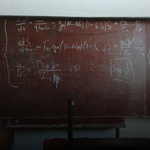Section 1
Preview this deck
L'Hopital's Rule
Front
Active users
7
All-time users
9
Favorites
0
Last updated
6 years ago
Date created
Mar 1, 2020
Cards (169)
Section 1
(50 cards)
L'Hopital's Rule
secxtanx
d/dx [secx]
d/dx [arccscx]
Mean Value Theorem
The instantaneous rate of change will equal the mean rate of change somewhere in the interval. Or, the tangent line will be parallel to the secant line.
d/dx [a^x]
d/dx [sinx]
Intermediate Value Theorem
If f is continuous on [a,b] and k is a number between f(a) and f(b), then there exists at least one number c such that f(c)=k
Horizontal Asymptote
0
f'(g(x))g'(x)
chain rule
d/dx [cotx]
Point of inflection at x=k
-csc²(x)
1
- cscxcotx
derivative of a log base a
Rolle's Theorem
Let f be continuous on [a,b] and differentiable on (a,b) and if f(a)=f(b) then there is at least one number c on (a,b) such that f'(c)=0 (If the slope of the secant is 0, the derivative must = 0 somewhere in the interval).
d/dx [cscx]
f(x)g'(x) + g(x)f'(x)
derivative of the multiplaction of two functions
product rule
cosx
derivative of a natural log
d/dx [a^x] =
sec²(x)
d/dx [arcsecx]
Alternative Definition of a Derivative
f '(x) is the limit of the following difference quotient as x approaches c
d/dx [cosx]
-sin(x)
d/dx [ln|x|] =
d/dx [cotx]
d/dx [tanx]
Combo Test for local extrema
If f'(c) = 0 and f"(c)<0, there is a local max on f at x=c. If f'(c) = 0 and f"(c)>0, there is a local min on f at x=c.
d/dx [arcsinx]
First Derivative Test for local extrema
sec(x)tan(x)
Global Definition of a Derivative
- sinx
chain rule
quotient rule
f is continuous at x=c if...
derivative of a power
d/dx [log_a X] =
d/dx [arctanx]
Extreme Value Theorem
If f is continuous on [a,b] then f has an absolute maximum and an absolute minimum on [a,b]. The global extrema occur at critical points in the interval or at endpoints of the interval.
d/dx [f(x)/g(x)] =
quotient rule
d/dx [arccotx]
d/dx [arccosx]
derivative of an exponential function
d/dx [tanx]
Section 2
(50 cards)
sec(x)tan(x)
If k is in the domain of f If f ''(k)=0 or does not exist If f ''(x) changes sign @ x=k
When is x=k a point of inflection?
ln(cscx+cotx)+C = -ln(cscx-cotx)+C
dy/dx
ln(a)*aⁿ+C
Define the Squeeze Theorem.
Suppose that g(x)≤f(x) and also suppose that {the limit of g(x) (as x goes to a)} = {the limit of h(x) (as x goes to a)} = L then {the limit of f(x) (as x goes to a) = L}
If we let f be continuous on [a,b] and differentiable on (a,b) and if f(a)=f(b) then there is at least one number c on (a,b) such that f'(c)=0 (If the slope of the secant is 0, the derivative must = 0 somewhere in the interval).
Define Rolle's Theorem.
Extreme Value Theorem
What theorem states that if f is continuous on [a,b] then f has an absolute maximum and an absolute minimum on [a,b]. The global extrema occur at critical points in the interval or at endpoints of the interval?
Fundamental Theorem of Calculus #1
The definite integral of a rate of change is the total change in the original function.
Inverse Sine Antiderivative
-ln(cosx)+C = ln(secx)+C
hint: tanu = sinu/cosu
1
1.) F(c) exists 2.) limit F(x) as x approaches c exists 3.) limit F(x) as x approaches c = F(c)
f is continuous at x=c if...
ln(secx+tanx)+C = -ln(secx-tanx)+C
-cos(x)+C
ln(x)+C
x+c
If f is continuous on [a,b] then f has an absolute maximum and an absolute minimum on [a,b]. The global extrema occur at critical points in the interval or at endpoints of the interval.
Define the Extreme Value Theorem.
sin(x)+C
uvw'+uv'w+u'vw
Squeeze Theorem
Define:
x+c
Derivative of ln(u)
Combo Test (Second Derivative Test) for local extrema
If f'(c) = 0 and f"(c)<0, there is a local max on f at x=c. If f'(c) = 0 and f"(c)>0, there is a local min on f at x=c.
0
sin(x)+C
-csc(x)+C
sec²(x)
Formula for Disk Method
Axis of rotation is a boundary of the region.
If f and g are inverses of each other, g'(x)
L'Hopital's Rule
Define:
Critical Number
If f'(c)=0 or does not exist, and c is in the domain of f, then c is a what? (Derivative is 0 or undefined)
Let c be a critical number of a function f that is continuous on the closed interval [a,b] that contains c. If f is differentiable on [a,b], then f(c) can be classified as follows... If f '(x) changes from a negative to a positive at c, then f(c) is a relative minimum of f. If f' (x) changes from a negative to a positive at c, then f(c) is a relative maximum of f
Define the First Derivative Test for local extrema.
Antiderivative of f(x) from [a,b]
Yes lim+=lim-=f(c) No, f'(c) doesn't exist because of cusp
Given f(x): Is f continuous @ C Is f' continuous @ C
Fundamental Theorem of Calculus #2
tan(x)+C
-csc²(x)
Formula for Washer Method
Axis of rotation is not a boundary of the region.
cos(x)
-sin(x)
ln(sinx)+C = -ln(cscx)+C
Inverse Secant Antiderivative
The Chain Rule: f'(g(x))g'(x)
sec(x)+C
Mean Value Theorem for integrals or the average value of a functions
Exponential growth (use N= )
Rolle's Theorem
What theorem states that if we let f be continuous on [a,b] and differentiable on (a,b) and if f(a)=f(b) then there is at least one number c on (a,b) such that f'(c)=0 (If the slope of the secant is 0, the derivative must = 0 somewhere in the interval)?
-cot(x)+C
Derivative of eⁿ
Section 3
(50 cards)
1/2
sin(5π/6)
Derivative of ln(u)
Define:
0
cos(π/2)
√2/2
cos(π/4)
√3/2
sin(2π/3)
Derivative of eⁿ
Define:
Inverse Tangent Antiderivative
Define:
√3/2
cos(π/6)
ln(sinx)+C = -ln(cscx)+C
sec(x)+C
0
sin(π)
Fundamental Theorem of Calculus #1
The definite integral of a rate of change is the total change in the original function.
1/2
cos(5π/3)
√3/2
cos(11π/6)
−√3/2
cos(5π/6)
d/dx (∫ˣ sub-c) f(t)dt = f(x)
What is the second fundamental theorem of Calculus?
g'(x)
Assume f and g are inverses of each other.
√2/2
sin(π/4)
ln(x)+C
Formula for Washer Method
Assume the axis of rotation is not a boundary of the region, and define:
0
cos(3π/2)
1
sin(π/2)
1/2
sin(π/6)
-cot(x)+C
-1/2
cos(2π/3)
Opposite Antiderivatives
Define:
The definite integral of a rate of change is the total change in the original function. ∫ₐᵇ f(x)dx = F(b) - F(a)
What is the 1st fundamental theorem of Calculus?
√3/2
sin(π/3)
√2/2
cos(7π/4)
Fundamental Theorem of Calculus #2
Inverse Secant Antiderivative
Define:
−√2/2
cos(3π/4)
-cos(x)+C
tan(x)+C
ln(secx+tanx)+C = -ln(secx-tanx)+C
ln(cscx+cotx)+C = -ln(cscx-cotx)+C
-ln(cosx)+C = ln(secx)+C
hint: tanu = sinu/cosu
Antiderivative of f(x) from [a,b]
Define:
Antiderivative of xⁿ
Define:
Formula for Disk Method
Assume the axis of rotation is a boundary of the region, and define:
-1
cos(π)
Constants in integrals
Define:
1/2
cos(π/3)
Adding or subtracting antiderivatives
Define:
ln(a)*aⁿ+C
-csc(x)+C
Mean Value Theorem for integrals or the average value of a functions
Define this statement:
√2/2
sin(3π/4)
Inverse Sine Antiderivative
Define:
1
cos(2π)
Section 4
(19 cards)



